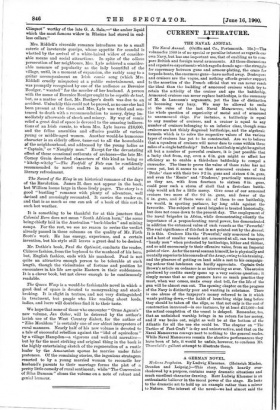CURRENT LITERATURE .
THE NAVAL ANNUAL The Naval Annual. (Griffin and Co., Portsmouth. 15s.)—The volume for 1900 is of no special or peculiar interest as regards our own Navy, but has one important use, that of enabling us to com- pare British and foreign naval armaments. All those discussions and expensive experiments which raged a decade ago—the struggle for supremacy between guns and armour-plating, the craze for torpedo-boats, the enormous guns—have melted away. Destroyers and cruisers are the vogue, and nothing affords greater support to the assertion of the French official that we can never reach the ideal than the building of armoured cruisers which try to retain the activity of the cruiser and ape the battleship. Armoured cruisers can never replace battleships, is the summary of N. de Lanessan's arguments, yet the line of distinction is becoming very hazy. We may be allowed to smile at the rules of the last Naval Manoeuvres, which beg the whole question of superiority of metal and of armoured to unarmoured ships. For instance, a battleship is equal to any number of cruisers, and a cruiser is equal to any number of cruisers belonging to an inferior class, though some cruisers are but thinly disguised battleships, and the algebraic formula which is to solve the respective values of the various types of cruisers has yet to be constructed. Are we to believe that a squadron of cruisers will never dare to come within three miles of a single battleship? Safe as a battleship might be against all but a number of powerful cruisers, it is just possible that a lucky shot from, say, even a 6 in. gun might so affect her efficiency as to enable a third-class battleship to compel a surrender. The time to prove the value of these rules has not come yet, but it seems to us that armoured cruisers of the 'Drake' class with their two 9.2 in. guns and sixteen 6 in. guns, and even the 'Kents ' and Diadems,' practically unarmoured as they are, with from fourteen to sixteen 6 in. guns, could pour such a storm of shell that a first-class battle- ship would ask for a little mercy. Give some of our armoured cruisers two more of the 9.2 in. guns, and fewer of the 6 in. guns, and if there were six of them to one battleship, we would, in sporting parlance, lay long odds against the favourite. The subject of naval brigades is treated historically, but does not come down to the present day. The employment of the naval brigades in Africa, while demonstrating silently the importance of ,a preponderating naval power, has demonstrated in addition the enhanced value of such vessels as the Powerful.' The real significance of this fact is not pointed out by the Annual. It is this Cruisers like the 'Powerful,' only armoured in bits, and a host of smaller vessels not armoured at all, can transport "handy men" when protected by battleships, hither and thither, and so add enormously to their offensive value, from an Imperial point of view. As for the naval seaman himself,he is physically and mentally superior to his comrade of the Army, owing to his training, and the pleasure of getting on land adds a zest to his campaign- ing ardour that landsmen can hardly appreciate. Captain Orde Brown's article on ordnance is as interesting as ever. The erosion produced by cordite surely opens up a very serious question; it eimply means that as our gunners have so much practice they must, when war comes, make every shot tell, for the life of the gun will be almost run out. The opening chapter on the progress of the Navy is distinctly poor and wanting in substance. There is one abuse of the taxpayer's money referred to in it which wants putting down,—the habit of launching ships long before they should be taken off the slips, so that not only is the cost of construction increased—in one instance, by at least £15,000—but the actual completion of the vessel is delayed. Remember, too, that an unfinished warship brings in no return for her money, and if war broke out, might as well be at the bottom of the Atlantic for all the use she could be. The chapter on "The Tactics of Fast Craft" is dry and nninstructive, and that on the Naval Mancenvres conveys next to nothing to the general reader. While Naval Manoeuvres remain the abortive performances they have been of late, it would be unfair, however, to condemn Mr. Thursfield's gallant attempt to illustrate them.






































 Previous page
Previous page